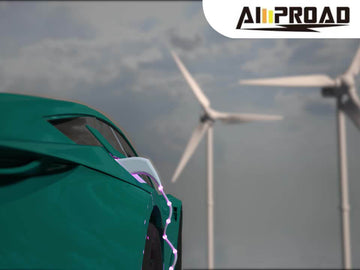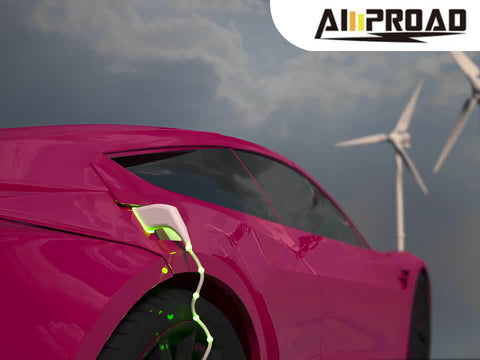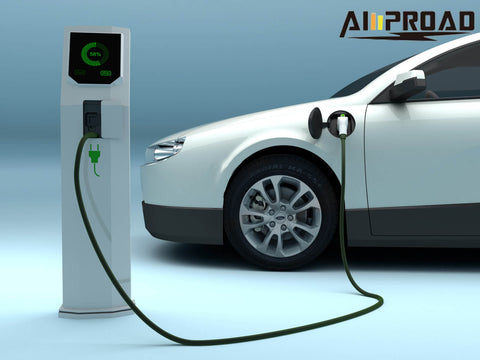
Level 2 EV chargers play a vital role in accelerating charging times compared to Level 1 chargers. While Level 1 chargers operate at standard household outlets, Level 2 chargers utilize higher voltage (typically 240 volts), enabling faster charging. Beyond merely focusing on kilowatts (kW), understanding the total power delivery becomes crucial. This shift emphasizes not only the kW rating but also factors like amperage and voltage. Amperage, measured in amps, directly influences charging speed alongside voltage. For instance, a Level 2 charger operating at 240 volts can deliver faster charging rates when paired with higher amperage. By grasping the nuances of total power delivery, users can make informed decisions when selecting a Level 2 EV charger, ensuring optimal charging performance for their electric vehicles. This understanding empowers users to choose chargers that align with their vehicle's capabilities and charging needs, ultimately enhancing their electric vehicle ownership experience.
Can we demystify kW by explaining power delivery?
Understanding kilowatts (kW) is fundamental to comprehending power delivery in Level 2 EV chargers. In simple terms, kW represents the rate at which energy is transferred or converted. When it comes to electric vehicle charging, kW indicates the charging capacity or speed. This metric is determined by both amperage (amps) and voltage. Amperage refers to the flow of electric current, while voltage represents the electrical pressure that drives the current. Together, they determine the overall power output of the charger.
How does amperage (amps) affect charging speed in Level 2 chargers, especially considering voltage?
Amperage plays a significant role in determining the charging speed of Level 2 chargers, particularly when combined with voltage. In Level 2 charging, higher amperage translates to faster charging rates. This is because a higher amperage allows for a greater flow of electric current, resulting in quicker replenishment of the electric vehicle's battery. When paired with the standard voltage of 240 volts in Level 2 chargers, higher amperage can significantly reduce the time required to charge an electric vehicle fully.
How many kW does a Level 2 charger use?
The power output of a Level 2 charger varies widely based on factors such as the charger's model, manufacturer, and specifications. Level 2 chargers typically range from 3.6 kW to 19.2 kW or higher. The kW rating directly influences the charging speed, with higher kW chargers enabling faster charging rates. It's crucial to select a Level 2 charger with a kW rating compatible with your electric vehicle's charging capabilities and your home's electrical circuit capacity. Additionally, consider your charging needs and preferences to determine the optimal kW rating for your charging setup.
For more specific information on the kW rating of a particular Level 2 charger, refer to the charger's specifications provided by the manufacturer. These specifications typically include details about the charger's power output, charging speed, and compatibility with different electric vehicle models. Additionally, consult with a qualified electrician to assess your home's electrical system and determine its capacity to support a Level 2 charger with your desired kW rating. By carefully evaluating these factors, you can ensure efficient and reliable charging for your electric vehicle.
What are the limitations homeowners should know about charging circuits?

Homeowners must be aware of the limitations of their electrical circuits when considering the installation of Level 2 chargers. One crucial limitation to consider is the capacity of the electrical circuit. Overloading the circuit can pose safety risks and lead to inefficiencies in charging. It is essential to ensure that the electrical system in the home can accommodate the amperage required by the Level 2 EV charger without overloading the circuit. Additionally, homeowners should consider the potential need for upgrades to their electrical infrastructure to support the installation of a Level 2 charger effectively.
Understanding kilowatts, amperage, and voltage is vital for demystifying power delivery in Level 2 EV chargers. By grasping these concepts and considering the limitations of home electrical circuits, homeowners can make informed decisions when installing Level 2 chargers and ensure efficient and safe charging for their electric vehicles.
How does the Level 2 Charger Power Delivery Spectrum vary?
Understanding the variability in Level 2 charger power delivery is crucial for optimizing charging efficiency. Ditching sole reliance on a single kW rating is imperative to tailor charging solutions to individual needs. Level 2 chargers present a diverse spectrum of kW options, ranging from 3.6 kW to 19.2 kW or beyond, each serving distinct charging demands. The interplay between charger design and car capabilities significantly impacts actual power delivery during charging sessions. Exploring this intricate relationship aids in making informed decisions regarding charger selection, ensuring seamless integration with your electric vehicle's charging requirements.
Why should we move beyond focusing solely on a single kW rating?
Relying solely on a single kW rating may not adequately address the diverse charging requirements of different electric vehicles and usage scenarios. By moving beyond this limited approach, users can tailor their charging solutions to match their specific needs, whether it be for daily commuting or long-distance travel. Additionally, considering factors beyond kW rating, such as charger design and car capabilities, allows for a more comprehensive understanding of power delivery dynamics, leading to more efficient and effective charging experiences.
What are the various kW options available in Level 2 chargers, and how do they differ?
Level 2 chargers offer a wide range of kW options, each catering to different charging needs. Lower kW chargers, such as those rated at 3.6 kW, are suitable for slower charging sessions, ideal for overnight charging at home. On the other hand, higher kW chargers, such as those exceeding 10 kW, offer faster charging rates, making them suitable for rapid charging needs or public charging stations. The choice of kW rating depends on factors such as the electric vehicle's battery capacity, charging requirements, and available infrastructure.
How do charger design and car capabilities impact actual power delivery?
he design of the charger and the capabilities of the electric vehicle play crucial roles in determining actual power delivery during charging sessions. Factors such as cable thickness, connector type, and internal charging algorithms can influence charging efficiency. Similarly, the electric vehicle's battery capacity, charging port specifications, and onboard charging systems impact how effectively it utilizes the charger's power output. Considering these factors holistically ensures seamless compatibility and efficient charging performance.
How can you match Charger Power to Your Needs?
Selecting the right Level 2 charger involves considering various factors to ensure it meets your specific requirements.
Choosing a Level 2 charger, it's essential to match it with your car's maximum supported charging rate. This ensures compatibility and optimal charging efficiency. Evaluate your home's electrical circuit capacity to ensure it can support the charger's power requirements. Overloading circuits can lead to safety hazards and inefficiencies.
How should one balance charging speed with cost when selecting a charger?
Balancing charging speed with cost is crucial when selecting a Level 2 charger. Consider your budget and desired charging speed to find the right balance between affordability and efficiency.
Selecting the right Level 2 charger involves considering various factors to ensure it meets your specific requirements. When choosing a Level 2 charger, it's essential to match it with your car's maximum supported charging rate. This ensures compatibility and optimal charging efficiency. Evaluate your home's electrical circuit capacity to ensure it can support the charger's power requirements. Overloading circuits can lead to safety hazards and inefficiencies. Balancing charging speed with cost is crucial when selecting a Level 2 charger. Consider your budget and desired charging speed to find the right balance between affordability and efficiency.
In addition to considering these factors, the AMPROAD iFlow P9 is an option worth exploring. This versatile Level 2 EV charger offers adjustable amperage ranging from 10A to 40A, allowing you to tailor the charging speed to your specific needs and electrical circuit capacity. Its portable design, featuring a standard NEMA 14-50 plug, ensures convenience for both home use and on-the-go charging. With optional Wi-Fi connectivity, the AMPROAD iFlow P9 enables remote monitoring and scheduling, enhancing user convenience. Moreover, its competitive price point makes it an attractive choice for those seeking a reliable and efficient Level 2 charger.
What are the Advanced Considerations regarding Energy Efficiency and Smart Charging?

Energy efficiency plays a pivotal role in enhancing the sustainability of EV charging operations. By maximizing the utilization of electricity and minimizing wastage, energy-efficient charging solutions help reduce overall energy consumption and carbon emissions. This not only benefits the environment but also contributes to cost savings for EV owners by reducing electricity bills.
Smart charging features introduce intelligence into the charging process, enabling EVs to communicate with charging stations and grid systems to optimize charging schedules based on factors such as electricity rates and grid demand. By leveraging real-time data and predictive algorithms, smart charging systems can schedule charging sessions during off-peak hours when electricity prices are lower and grid demand is minimal. This not only reduces charging costs for EV owners but also alleviates strain on the grid, promoting more efficient use of energy resources. Additionally, smart charging can facilitate integration with renewable energy sources, allowing EVs to charge when solar or wind energy generation is at its peak, further enhancing sustainability. Overall, smart charging technologies play a critical role in maximizing energy efficiency and ensuring the seamless integration of EVs into the broader energy ecosystem.
Understanding the Importance of Considering All Factors
Selecting the right Level 2 charger involves careful consideration of various factors to ensure optimal performance and compatibility with your electric vehicle (EV). By evaluating these factors comprehensively, you can make an informed decision that meets your charging needs and enhances your overall EV ownership experience.
Key Takeaways on Considering All Factors
When choosing a Level 2 charger, it's essential to assess factors such as power output, connectivity options, durability, safety certifications, warranty coverage, brand reputation, price, and portability. Each of these factors plays a significant role in determining the suitability of the charger for your specific requirements. For example, higher power output (measured in amps) translates to faster charging speeds, but you must ensure compatibility with your EV's charging capabilities and your home's electrical circuit capacity.
Considering connectivity features like Wi-Fi and smartphone apps allows for convenient monitoring and control of charging sessions, while durability and weatherproofing are crucial for withstanding various environmental conditions. Additionally, prioritize chargers with safety certifications such as CSA to ensure compliance with Canadian safety standards.
Evaluate the warranty coverage offered by different charger manufacturers, as well as their reputation for customer service. While price is an important consideration, it's essential to balance features and functionality with your budget. Lastly, consider whether portability is a requirement for your charging needs, especially if you need a charger for both home and on-the-go use.
Additional Resources for Further Information
For further information on charger specifications and electrical system capacity, consider consulting resources such as manufacturer websites, EV forums, and government publications. Manufacturer websites often provide detailed specifications and compatibility information for their chargers. EV forums and online communities are valuable sources of real-world user experiences and recommendations. Government publications and websites may offer guidelines and resources related to EV charging infrastructure and incentives. By leveraging these additional resources, you can gain a deeper understanding of the factors involved in choosing the right Level 2 charger for your EV.
FAQs / People Also Ask
What if my charger's kW rating is higher than my car's acceptance rate?
The car will only draw the power it can handle. You won't damage the car, but you won't get the fastest possible charging speed.
Is there anything else to consider besides kW?
Yes! Amps (amperage) also play a role. Higher amps alongside the appropriate voltage (typically 240V in Level 2) translate to faster charging.
Where can I find more information about specific charger kW ratings?
The charger manufacturer's website or user manual.
Online retailer listings for the charger model you're considering.
Is there a way to optimize my charging experience?
Yes! Some Level 2 chargers offer smart charging features. These features can adjust charging based on factors like electricity rates or time-of-use plans (if applicable) to potentially save you money.



